



Saturn has many moons, but only eight are bright enough to be seen in typical amateur telescopes. In order of distance from Saturn, these include; Mimas, Enceladus, Tethys, Dione, Rhea, the largest Titan, Hyperion and Iapetus. Together, these eight are often referred as the major Saturnian satellites. Two other are possible to see, but are much fainter. The furthest out is Pheobe, which takes one year five month to orbit once and requires a sizeable telescope to see. More more difficult is Janus. Its orbit lies close to the edge of the rings and is only when the rings are placed edgewise towards Earth.
The remainder of the lesser satellites are mostly small, being an assortment of rocky and icy worlds. Six of these are associated within the rings, these moons contribute much of the long-term stability of the rings by “shepherding” the broken ring structure. Most of the smaller moons are totally invisible to amateur instruments. In recent times the number of known Saturnian moons has increased to more than thirty, with many being discovered between 2000 and 2002. In September 2003 the number of moons had increased to 31, and by mid-2005, Saturn has listed 50 in all.
*****************************************************
No. Name Period Distance Diameter Mag.
(days) (km.) (km.) (vis.)
*****************************************************
I Mimas 0.94 185 520 392 12.9
II Enceladus 1.37 238 020 500 11.7
III Tethys 1.89 294 660 1 060 10.2
IV Dione 2.74 377 400 1 120 10.4
V Rhea 4.52 527 040 1 530 9.7
VI Titan 15.95 1 221 830 5 150 8.3
VII Hyperion 21.28 1 481 100 205x130x110 14.2
VIII Iapetus 79.33 3 561 300 1 060 11.1
IX Phoebe 550.48 12 952 000 220 16.5
X Janus 0.69 151 472 110x100x80 14
XI Epimetheus 0.69 151 422 17x60x50 15
XII Helene 2.74 377 400 18x16x15 18
XIII Telesto 1.89 294 660 17x14x13 18.5
XIV Calypso 1.89 294 660 17x11x11 18.7
XV Atlas 0.6 137 670 20x10 18
XVI Prometheus 0.61 139 353 70x50x40 16
XVII Pandora 0.63 141 700 55x45x35 16
*****************************************************
MIMAS is a small world which was discovered by the English astronomer Sir William Herschel in 1789. In legend Mimas was a Giant and a son of Gaia (Earth) who was eventually slain by Hercules. Orbiting Saturn at the distance of about half that of the Moon (185 520 km.) in a short period of 0.94 days. In size this small moon is only 392 km across.
Mimas is dramatically marked by a huge 130km impact crater on its surface, and is often whimsically labelled as “The Death Star” after the moon-sized spacecraft in George Lucas’ popular film Star Wars. The original impact shattered Mimas into large pieces that recombined into the appearance we see today, and luckily, Mimas was not destroyed. The large crater is named Herschel and has a huge ‘dimple’ in the crater centre. Its scale is a stupendous, whose depths descend between 5 to 10 km into the crater, and whose central peak rises almost 6 km. This suggests that the impact made the icy surface turn liquid only to reset into the observed impact shape. On the opposing side of this moon is clear evidence of huge cracks and fractures across the surface caused by the impact of some other moon or asteroid in the distant past. (Two image of Mimas’ surface appear in the figure below) Most of the other craters and chasms have been named after the people and legends in King Arthur and some of the places around Camelot. In composition, Mimas seems to be mainly water ice mixed with a small amount of rock. Mimas is visible in amateur apertures of 25cm or 30cm and is best seen only during a short time during its greatest eastern or western elongations. At Saturn’s opposition Mimas reaches about magnitude 12.9.
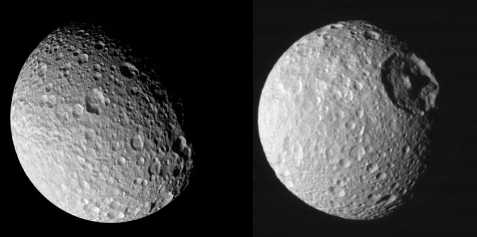
Fig. 5-5. MIMAS : An Almost Destroyed Moon. |

Fig. 5-6. ENCELADUS |
ENCELADUS lies between the orbits of Mimas and Tethys at a distance of some four Saturn’ radii or 238 020 km and orbits Saturn once every 1.37 days. It was discovered by William Herschel in 1789, being named in Greek mythology after the giant who died in battle and was buried under Mt. Edna by Athena.
This slightly brownish-yellow moon is believed to be the most reflective body in the Solar System. The moon itself is roughly spherical whose shapes is given as 256x247x245km. Enceladus show evidence of recent geological activity including recent volcanism (as water fountains) which is likely caused by the tidal forces exerted by Saturn and nearby Dione. Some regions on Enceladus display varied surface features that are both cratered and fairly smooth. Evidence also exists that Enceladus has a tenuous atmosphere which is being being replenished by the presumed geological activity.
With an average 11.8 magnitude, it is visible in apertures as small as 15cm or 20cm.
TETHYS is the third major satellite out from Saturn whose name derives from Greek mythology from one of the six Titaness, and she was commonly associated with the fertile sea. In legend she born from the union of Uranus and Gaia, and was both the wife and sister of the Titan, Oceanus.
Tethys was descovered telescopically by Gian Domenico Cassini in 1684. This particular Saturnian moon bears remarkable resemblance to the next outermost satellite Dione, whose diameter is about 1 060 km and whose composition is mainly frozen water ice. The moon orbits some 294 660 km from Saturn in a period of 1.8878 days. Tethys appears as third brightest moon of Saturn, shining at opposition at 10.2 magnitude, following Titan then Rhea.
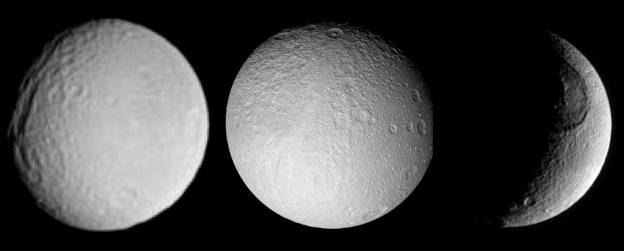
Fig. 5-7. THREE VIEWS of TETHYS |
A huge 250km sized crater named Odysseus that appears on its surface, however unlike Mimas, the impact did not shatter the moon. Opposing this crater is a huge 2 000 km long canyon named Ithaca Casma as swathing across Tethys’ equator. In places the canyon is 100 km wide and sinks to a depth of 4 km.
Tethys has two smaller companions named Telesto (XIII) and Calypso (XIV) lying about 60o both ahead and behind, respectively. These occupy the so-called Lagrangian points, within the same orbit as Tethys itself, and this is similar to the Trojan asteroids that appear before and after Jupiter’s orbit.
DIONE in Greek mythology was born either as a daughter of Oceanus and Tethys or as one of the original Titans (as one of the six Titaness). Her child was Aphrodite and her husband was Zeus. Dione lies within six Saturn radii of the planet or 377 400 km from Saturn itself - equivalent to the distance between the Earth and the Moon. It orbits the planet in 2.737 days - the same as the rotational period. The moon was discovered by Gian Domenico Cassini in 1684 has a diameter of 1 120km - second only to Titan. Dione at opposition is quite bright at 10.4 magnitude, following slight behind by the closer moon to Saturn, 10.2 magnitude Tethys. Sometimes amateurs can be confused in which moon they are looking, and it is wise to confirm each moon with an ephemeris of the Saturnian moons.
Dione is a brownish colour world and is likely a mixed slurry of water and ices but does have a significant rocky materials like silicates. In some ways Dione looks like a less damaged by craters than nearby Rhea The moon has some odd features, such as being heavily cratered on the trailing side hemisphere rather than the typical leading side as seen on the other Saturnian moons.
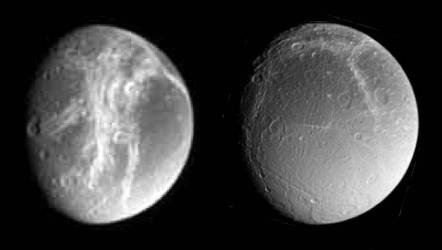
Fig. 5-8. Two Faces of DIONE |
A relatively poor first image was made by Voyager 1 on the 11th November 1980. However, the improved images taken by Cassini in 2005 clearly show more intricate patterns of white material. To me it looks like some child scrawling it’s hand randomly across the moon’s surface, digging up the pristine ice from Dione underground.
Dione also has a companion moon, Helene, which precedes 60o preceding at the Lagrangian point. Helene was found by the French astronomers P. Laques and J. Lecacheaux from ground-based telescopes in 1980, in size this “co-moon” is a small iregular 36x32x30 kilometres.
RHEA is the second largest moon of Saturn, which it shares almost equally with the next outermost satellite Iapetus. Discovered by Italian-French astronomer Giovanni Domenico Cassini in 1672, this interesting moon is some 1 530 kilometres in diameter, whose period is some 4.517 days in length. Like the Earth’ own Moon, Rhea keeps the same face always pointing towards Saturn and orbits some 527 000 kilometres above Saturnian cloud tops.
As one of the Titans in Greek mythology is either the wife and sister of Cronus (Saturn) and the mother of Zeus (Jupiter) who is identified as a fertility goddess. In some versions of ancient Roman mythology she was known as Ops and worshipped as magna mater - the Great mother goddess. Rhea was also one of the principal gods of Crete. Her six children were the male gods; Zeus, Poseidon, Pluto, and the female goddesses of Hestia, Hera, and Demeter.
When Voyager 1 passed with 80 000km of its surface, it found to be a heavily cratered world that appears slightly bluish in colour. Cassini again observed the moon in much detail in early August 2005. Here the craters are seemingly eroded by water ice flows with the addition of some significant resurfacing in its polar regions. Evidence suggests this has been recently formed. Some regions (See Fig. 5-9.) show a swath of white icy material across the surface.
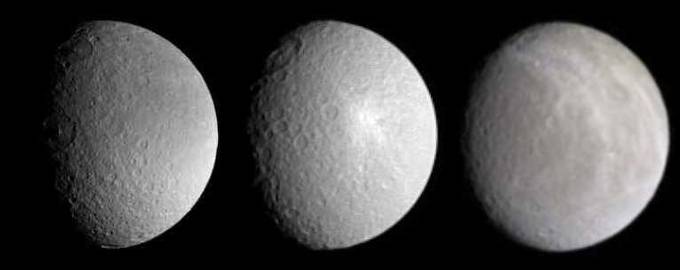
Fig. 5-9. Three Faces of RHEA |
Rhea is littered with many craters on its leading face and seems to be composed of much darker material than the moon’s trailing side. Some have correctly pointed out that in some ways Rhea looks more like our own Moon or even Mercury. One thing about the craters that is different from our Moon is that the walls of the craters are not as tall and nor are the central peaks inside them. As the mean density is 1.3 g.cm-3, this indicates mainly water ice mixed with some rocky material. It is quite likely the impacts caused the watery material to flow differently than impacts into solid rock. One of the largest crater on Rhea is Izanagi, which is positioned near the polar regions. On the opposing trailing side of the moon find bright rays of white highly reflective material that looks awfully like some of the rays seen on the lunar surface. One of these looks like someone has just thrown a large snowball towards Rhea, with the resultant ‘splat’ strewing material falling across the surface from the impact site. Yet another white material arc encircles about one-third the diameter of Rhea. On this side are fewer craters and quite different terrain.
Like Dione, Rhea is detectable through 7.5cm., though amy 10.5cm. would be far more suitable.

TITAN was discovered by Christaan Hugyens in 1655 and is the largest moon in the Saturnian system. It is the second largest in the Solar System - just behind Jupiter’s Galilean satellite Ganymede, and is larger than Mercury. Visible even in 7.5cm, Titan's true diameter is 5 150 kilometres across and is the only known satellite that has a substantial atmosphere. This was found by Gerard Kuiper in 1944 during the Second World War who later became an early expert and discoverer about the regions containing the outer planets. Before the Voyager 1 and 2 spacecraft reached Saturn, no one knew what Titan’s surface was like but it was assumed that we could see through the cloud tops - a feature of the imaginative artwork of the Solar System made during the mid-20th Century. Voyager 1 passed in November 1980 within 7 000 km of the moon but revealed no surface details but instead found the 100 km thick orangery coloured atmosphere descending to a surface pressure some 1.6 times of Earth. Particular interest for planetary scientists is this orange-coloured atmosphere, but why it has survived is not known - especially when it is generally believed that long ago all the other satellites in the Solar System had quickly lost their atmospheres. This unique atmosphere is mainly composed of nitrogen (83%), methane and argon, with traces of carbon monoxide and other hydrocarbon and nitrogen compounds. The atmosphere’s colour would be expected to be nearly transparent or pure white with this composition, but it is likely tainted with aerosol layers of organic chemical compounds.
Variations in the atmospheric colour were also found to be divided into two distinct parts. The southern hemisphere was noticeably brighter and the north hemisphere pole appeared much dark. Although we do not know the orientation of Titan’s axis regrading the ecliptic, the division is the atmosphere is thought to correspond roughly with this moon’s equator. It also seems unlikely that this division is caused by seasonal effects or by Titan’s actual surface as it is too far from the Sun. These variations may be caused by the amount of crystallised methane in the cloud layer which hanges depending on the inclination of the Sun in Saturn's orbit. This may also account for the slight observed changes in Titan’s visual magnitude observed over the last twenty years that has remained unexplained.
Some presently believe Titan atmosphere maybe very similar to the Earth’s some three-and-a-half billion years ago. Titan is considered important to study because the material is likely still in pristine state and unaffected since the solar system’s formation. Investigation may reveal much about the composition of the original solar nebula - something we still know so little about.
Lying so far away from the Sun in the cold depths of the Solar System makes the mean temperature of Titan’s cloud tops to be around -200oC (70K). Some areas of the surface may possibly be composted of a mixture of the liquids of nitrogen, ethane and methane combined with floating pieces ‘iceberg ’ sized blocks of methane and carbon dioxide (dry ice)! Evidence of some organic materials and hydrocarbons have also been found such as acetylene, ethane, ethylene and hydrogen cyanide. This makes Titan a veritable rich organic soup - having all the necessary ingredients to make the amino acids for life. Had Titan been closer to the Sun the evolution of the moon may have had a much different story.
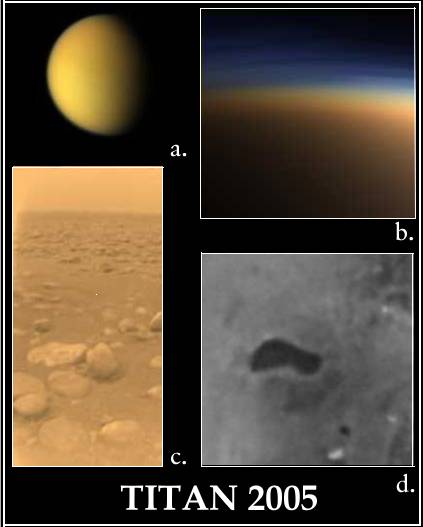
|
(a.) TRUE COLOUR IMAGE of TITAN OBSERVED CASSINI
(b.) HUYGENS DESCENDS
(c.) HUYGENS LANDING PLACE on TITAN
(d.) LAKE DISCOVERED on TITAN
The lake here is probably composed of liquid hydrocarbons at about 90K. (Image July 2005) Courtesy : NASA/JPL
Cassini took this combined image (Fig.5-1 b.) using the wide-angle camera and red, green and blue spectral filters, showing the true colour of Titan’s active upper atmosphere. They were taken some 9,000 km above from Titan on a Cassini fly-by on 31st March 31 2005. Here methane (CH4) is being bombarded by the Sun’s ultra-violet radiation, which in turn forms more complex organic molecules like acetylene (C2H2) and ethane (C2H6) Although the image seems quite Earth-like, the blue haze is caused by light scattered by ethane in the blue and ultraviolet wavelengths of light. The lower atmosphere is a thick orange-brown haze which is at a higher atmospheric pressure than Earth. Comprised of many complex organic molecules, the materials at ground level produces a haze that is only as bright as a full moon illumination seen on Earth at night. (See 5-1 c.)
[ More information on the Cassini-Huygens mission can be obtained at http://saturn.jpl.nasa.gov or additional images at http://ciclops.org ]
Surprisingly what is quite absent in the atmosphere, and likely any oceans, is water. At the these low temperatures water vapour cannot exist, yet it is likely from the known low density of Titan, that much of the inner bulk of the satellite is composed of water. The atmosphere also acts like a small greenhouse, raising the mean surface temperature by twenty-odd degrees higher (94K) than what is expected this far away from the Sun. Life likely does not exist there at the moment. Possibly several billion years from now when the Sun has swollen into a red giant, the substantial increase in temperature may make Titan for a more suitable environment for life - but this time will only be brief.
Titan is easily seen in small telescopes orbiting in the same plane orientation as the rings. Orbiting Saturn every 15d 23h, Titan appears as a rosy-yellow 8.4 magnitude "star" up to 3.5' east or west of the planet and roughly five times distance of the rings or twenty times the diameter of the planetary disk. The Cassini spacecraft mission has investigate Titan in detail as a special dedicated target that includes the dedicated ESO’s surface and atmospheric probe, Huygens. Cassini will reach Saturn sometime in June 2004 and Huygens to descend into the atmosphere in December of the same year. Much anticipation awaited the arrival of this craft and it images recieved proved it is truly a bizarre and alien world.
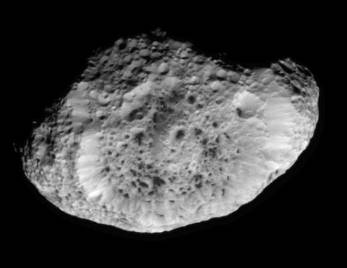
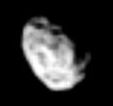
Fig. 5-10. HYPERION |
HYPERION in Greek mythology is named after one of the original Titans; being the son of Gaea and Uranus. He is often described as either a Sun-god, the God of Observations or sometimes even the Titan of Light. In the Greek mythological tale, has does not seem as important role - bring more remembered for his children and his father than himself. He later married his sister Theia also known as Athera or Euryphaessa, who became known also as the goddess of Sight. She was also able to make divinations and prophesying the future and her eyes were said to shine light like a glowing lamp. Three of their children became important Greek Pantheon of gods; being Helius (Sun), Selene (Moon) and Eos / Aurora (Dawn).
(For more detailed information on Greek mythology, see Homer’s THE HOMERIC HYMNS or Hesiod’ The Theogony. Here latter quotes the following verse;
“Theia yielded to Hyperion’s love and gave birth
to great Helios and bright Selene and Eos,
who shines upon to all the mortals of this earth
and to the immortal gods who rule the wide heaven (sky).”
(Hesiod, The Theogony, 371-374)
His son, Helios was given in the early Greek myths as Sun god, who is later times was instead replaced by the Sun worship of the god Apollo. Helios, other than the Sun, has not been used as a name the Solar System
Hyperion lies some 1 481 000 million kilometres from Saturn, and some 500 000 km outside the orbit of Titan - taking just over twenty-one days for one whole orbit. According to Roger Sinnott (S&T., pg. 101; October (2001)) Titan and Hyperion line up every six-four days on the eastern side of Saturn, as the orbital periods are synchronised in a ratio of 3:4.
Discovered by William Bond, George Phillips Bond and William Lassell on the 06th September 1848, this oddly potato-shaped moon has a size of about 400x220km with mean diameter of 266 km. Voyager’s 2fly-by in the late August 1982 passed at some distance, but was far more closely investigated by Cassini in September 2005.
Hyperion seems to be one of the largest bodies in the Solar System to be found as non-spherical. Unlike most of the larger moons that are continuously facing the same side towards Saturn, Hyperion tumbles end over end in its orbit, which is described as being chaotic and unpredictable. Some planetary astronomers suspect Hyperion maybe a piece of another moon that was fragmented by some long-ago collision. Evidence appears with the surface features like the huge 120 km. crater named Helios, after the Sun god, which is about 120 km in diameter and perhaps 10 km deep. Yet another large crater is Bahloo - the moon god, named after a ancient legend known by the indigenous Australian Aborigines. Hyperion also has a very low density (c.1.1 g.cm-3) suggesting is is composed of nearly pure water ice. This seems to be contradicted by its low albedo from dark material across the surface of the moon - a problem also faced by neighbouring Iapetus. Some have speculated Hyperion might even be partly hollow!
Furthermore, as although the moon is about the same size as the next outermost satellite Phoebe, the moon itself appears six times brighter than it. Some have even claimed that Hyperion is easier to find than the much larger Mimas, even though the latter is somewhat brighter. The likely reason is likely that Hyperion for visual observers remains well away from the glare of Saturn. A 20cm is needed to see Hyperion.
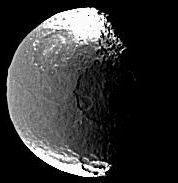
Fig. 5-11. IAPETUS |
IAPETUS, sometimes referred in older astronomical texts as Japetus, is named in Greek mythology as one of the Titans and is believed as an ancestor of the human race. He was the father Prometheus, Atlas Epimetheus, and Menoetius. Iapetus orbits Saturn in a 79.33 year period at the mean distance of 3 561 000 km. It is third largest of the Saturnian system behind Titan and Rhea.
Iapetus itself is an unusual moon because it changes by about two magnitudes throughout its orbit. It appears that the bright surface on one side, the one favouring the western elongations, have a reflectance (or albedo) of about 50%, while the darkened side is merely 2% or 3%. Jean Dominique Cassini first observed this in 1706, when he could not see the moon during the opposing eastern elongations. Like our Moon, Iapetus has been locked into a synchronous orbit, but this does not align with the dark and light portions of the satellite.
We know Iapetus as a 718km sized icy world having the mean density is about the same as pure distilled water ice, so we suspect that the surface is sprayed or coated with dark surface material - possibly from a rouge comet that has hit it in the past, or even by a substantial collision with the nearby dark, 5% albedo satellite of Phoebe. Another theory is that Iapetus brought the material to the surface from past geological activity.
An interesting image was obtained by Cassini that shows both polar regions as white ice with a swath of material distributed across the equatorial and temperate regions. The image attached shows also a large dark crater which looks even larger than the crater Herschel on Mimas,
Iapetus has a mean orbital distance of some 3.5 million kilometres. It takes 2 months 2 weeks or 79.3 days for one full orbit. The orbit of Iapetus is inclined 14.7o to the ecliptic, and every 14 of 16 years, some two years before the rings appear edgewise. Iapetus can either eclipse or occultate the ring plane as it did in 1978. Observations of this phenomenon are very rare.
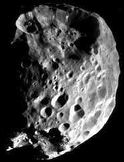
Fig. 5-12. PHEOBE |
PHOEBE is the second last of the main Saturnian moons. In mythology, she is also known under the alternative name Artemis, the goddess of the Earth’s own Moon. Pheobe was the daughter of Uranus and Gaia, who married her brother Coeus. Pheobe had several children, and the most renown was the goddess of the stars, Asteria, and her twin brother, Apollo the sun god. It is also the feminine form of name Phoebus - largest of the two Martian satellites. With Pheobe’s high lineage in regards the heavens, it is a pity her name was not reserved for a much bigger moon!
I have never read any observational reports of amateurs finding or even seeing Phoebe; likely I suspect because of its faint 16.6v magnitude. This moon was discovered well away from Saturn by W. Pickering in 1898 using 60cm, so I do suspect the larger Dobsonians could see it with care. Phoebe’s distance from Saturn is some 12.9 million km and takes some 1 year 5 months or 550.48 days for one whole orbit. Its true size it is only 110km across and is placed in an highly eccentric retrograde orbit.
Pheobe has been approached by the Cassini spacecraft revealing an oddly round rocky body littered with variously sized craters. (See image)
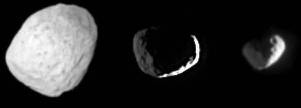
Fig. 5-13. Three Cassini Images of JANUS |
JANUS is the closest of the main Saturnian moons and is much more difficult to see. Janus which orbits very close to the edge of the rings and some 151 470 kilometers from Saturn, and taking just 0.69 days to circle the planet. Janus can only be viewed when the rings are placed edgewise towards Earth. The moon was discovered only fairly recently during 1966, displayed as a round dot silhouetted upon the rings. At maximum brightness, Janus can reach 14.0 magnitude, but whose light is easily swamped by the much brighter rings. Janus only measures about 110x100x80 kilometers in size.
Since the Voyager spacecraft visited Saturn in the 1980’s, more moons have been found by ground-based observatories. Many of the new satellites were found in 1999 and 2000 by astronomers looking for faint satellites around the planet. Often these remain as alphanumeric codes bodies and are often not named until a few years later - mainly once they have been confirmed independently. For Saturn, the provision code is written as ‘S/2000’ meaning it was discovered as a Saturnian Satellite in 2000. [Incidentally, for the other planets the first letter is J for Jupiter, U for Uranus and N for Neptune.] If two are more are discovered in the same year, then this code is followed by S1, S2, S3, S4... etc. In 2000, twelve new moons were discovered, so each moon is named S/2000 S1 through to S/2000 S12.
The exclusively agreed naming rights are given authority to the International Astronomical Union (IAU) and are names for the new confirmed moons are made at there General Assembly. Coincidentally, the last one was held between the 13th and 26th July 2003 in Sydney, Australia. On the 25th the Naming Committee endorsed the new satellites of twelve for Saturn, eleven for Jupiter and one for Uranus. For Solar System objects it was common to use either the names for the Roman and Greek gods, but they are fast running out of names under mythology. One of the final ratifications is to give a Roman Numeral for the satellite in order in preference from he closest to the furthest from the planet. For the Saturnian moons it was decided to use the gods of other nationalities and the new ones were taken from Nordic and Inuit (Eskimo) gods. None could ever be seen in any amateur telescopes because they are very small and very faint. Table 2 below gives the names for these newer satellites as of 2003;
******************************** No. Old Name New Name ******************************** XIX S/2000 S1 Ymir XX S/2000 S2 Paaliaq XXI S/2000 S4 Tarvos XXII S/2000 S6 Ijiraq XXIII S/2000 S12 Suttung XXIV S/2000 S5 Kiviuq XXV S/2000 S9 Mundilfari XXVI S/2000 S11 Albiorix XXVII S/2000 S8 Skadi XXVIII S/2000 S10 Erriapo XXIX S/2000 S3 Siarnaq XXX S/2000 S7 Thrym [XXXI] S/2003 S1 Unnamed ********************************
The last thirteen (13) discovered moons (not listed above) found from Earth-based observatories. These have all proved to be small dark coloured bodies with small diameters - perhaps somewhere between two and seven kilometres across. Twelve of these later moons were discovered by deep-imaging by David Jewitt, Jan Kieyna and Scott Sheppard. All but one of these orbit Saturn opposite or retrograde from the planetÙs rotation, being highly inclined to the ecliptic and with high orbital eccentricities. Four of the fifty satellites to date have been discovered by the Cassini spacecraft, one presently provisionally named S/2005 S1, was found within the Outer A ring in the so-called Keeler Gap.
The user applying this data for any purpose forgoes any liability against the author. None of the information should be used for regarding either legal or medical purposes. Although the data is accurate as possible some errors might be present. The onus of its use is place solely with the user.
 (NO ADS!)
(NO ADS!)